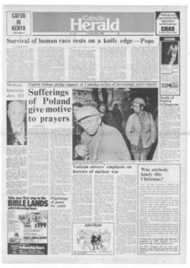Page 7, 1st January 1982
Page 7

Report an error
Noticed an error on this page?If you've noticed an error in this article please click here to report it.
Tags
Share
Related articles
Epiphany Is More Than Meets The Eye
`we Three Kings Of Orient Are. .' Or Are They ?
Peculiar Gifts Of The Magi 4jchartcrhouse2 Nchrorucle
"`"che Gentiles Shall Walk In `thy Light
Ichildren's Corner
The three wise men symbols of all humanity
Fr John Gallaher S. J. introduces us to the lesser-known facets of Gaspar, Melchior and Balthazar.
THE FEAST of the Epiphany on January 6 was celebrated in ancient times even more
splendidly than Christmas.
Even today it has the place in the eastern Church that Christmas has for us. It is the great celebration of the epiphany or manifestation of the Lord.
The three manifestations of his glory are taken together — the homage of the wise men from the East, the baptism of Christ in the Jordan, and the marriage feast of Cana.
Pope St Leo the Great who died in Rome in AD 461, wrote that the feast was a jubilant commemoration of how the Magi, the first-fruits of the Gentiles, hastened to Christ, and how Christ's incarnation shone forth in all its splendour, inviting the peoples of the world to the knowledge and love of their divine Saviour.
These wise men were the representatives of all humanity. It was the beginning of the great missionary work that has been entrusted to all Christmas. Since that day the Church has shown the star of the Gospel to all men of goodwill.
The epistle of the Epiphany Mass has the striking words of Isaiah, "Arise, be enlightened 0 Jerusalem, for thy light is come and the glory of the Lord is risen upon thee . . . and the nations shall walk in thy light."
It is a long process. It goes through all time and will find its fulfilment in eternity. St John Chrysostom points this out; "There are two manifestations of Christ.
"The first is that which has already happened. The second is the one of the future which will come at the end of time sk lin great splendour and majesty."
Since the time of the catacombs paintings of the scene have been one of the favourite ways of depicting Christ's manifestations to the whole men.
These men from the East (Persia or Babylon or Arabia) are represented in the early paintings and mosaics by two, three, four or more.
The Gospel does not give us the number. The traditional three Magi is probably based on the fact of their threefold presents — gold, incense, myrrh. They were popularly called saints, and their veneration spread over Europe. In some countries, Holland and Germany, the feast is known as the "Feast of the Three Kings".
The way that the time and place of Christ's manifestation was chosen clearly shows the providence of God. Three hundred years before Christ's birth there was the spread of Greek influence, the "Hellenisation" of the eastern Mediterranean world, of which the small kingdom of the Jews was part.
Alexander the Great had become one of the great military conquerors of history. He died young, but his leaders spread the civilisation based on Greece and it helped to unify the very different peoples of the Levantine Mediterranean world.
Two hundred years later, the rapidly growing Roman republic absorbed these same countries and gave them political order. When Christ appeared among men, the world was at peace under the first Roman emperor.
The Epiphany feast comes first upon the joys of Christmas, bringing hymns of an oriental flavour and an awe-filled spirit that echoes the adoration of the Magi down through the Christian centuries.
The famed carol, We three kings of Orient are,brings this out.
In the 12th century, the kings received the names Gaspar, Melchior and Balthazar. The three gifts they brought show the power and vision of the ancient world. Gold is the symbol of power in every age of man.
The gold was placed solemnly before a Child who would live in poverty all his earthly life, and who was to clear the great temple of Jerusalem of money changers and merchants.
Frankincense was given as a token that the old rituals of the pagan times were over, and the old altars were sealed away for_ ever because life had come upon the earth.
Myrrh was given as well, a pre-. cious ointment for the comfort of the dead. It was given in anticipation of Christ's death.
As the Egyptians mummified their dead and sought to embalm them in precious rites against' destruction in the grave, myrrh represented man's seeking after eternal life.
The Magi prostrated themselves before the Saviour who was prophecied in their • ' ancient books. They repres'enteo the ancient theology of pagan days with its lore and magic. They knelt before Christ who placed love above words, truth above superstition.
January days tend to be long and dark and wintry. But the light is beginning to appear. "God whispers to us in our pleasures. He speaks to us in our duties. He shouts at us in our pain — his loudspeaker for rousing a deaf world."
The following of Christ for. most of us is a peaceful serene . experience. "Feeling your heart on fire," as the two disciples expressed it on the way to Emmaus when they encountered the Lord, is pretty much our experience as we meet Christ on our way to eternity. It comes to different people in , different ways. A close friend told me what a joyful moment it was when she and her husband decided to have their third baby at home, with the help of a nurse midwife.
The child was due around Christmas. Marianne writes: "After much prayer we decided to make this birth an event to strengthen our family. Christmas became alive for our children." Then came the moment of joy; she tells how at the moment of his birth the baby was first touched by his father then held in the eager joyful arms of his mother.
"The feelings are almost impossible to describe, just a real closeness to our Lord. In minutes, our children and friends were at our side gazing at this beautiful baby boy."
Another close friend, Jill Duncan "found joy in the rising and setting sun, in the miracles of nature, especially in births of all kinds, in music and singing.
Jill has been in a wheelchair for 28 years. We all have our own experiences of Christ's manifestation in our lives.
blog comments powered by Disqus











